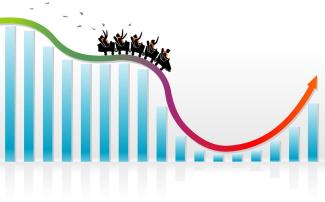
Market Volatility and your Portfolio
Volatility is a measure of the variation (the highs and lows) of a stock’s price returns over a period of time. As a measure of risk, volatility indicates how much and how quickly the price of an investment can change. Volatility is calculated as the standard deviation of historical investment returns from their expected return. Return volatility, as measured by standard deviation, is the risk that an investment will not meet its expected return in a given period of time. The smaller an investment’s standard deviation, the less volatile or risky it is perceived to be. The larger the standard deviation, the more scattered the return outcomes, and the investment is considered more of a risk to investors. It is important to remember that standard deviation is not a relative measure which means that it is best used only when in the context of a comparison of similar or like securities or with a compatible benchmark.
Is market volatility then good or bad? Depends. With higher volatility comes a diminished ability of the investor to accurately predict the expected return of an individual stock or a portfolio of risky assets. The trade-off here is that with higher volatility often comes the potential for larger share price gains. In the short term, while the wider range of investment outcomes presents a challenge to investors, in the long term those same challenges may be viewed more as an opportunity, While many investors view volatility as a negative, analysts and fund managers often see an increase in volatility as signaling a change in market direction before a rally. Mark Mulholland, manager of the Matthew 25 mutual fund, offered the following insight. “Volatility is not a risk for long term investors like business risk (product or service obsolescence) or financial risk (excessive debt or liquidity problems), to name a few examples. When the price of a stock (or market) falls, it is normal to think that something has changed for the worse – while that will happen sometimes, it will be the exception and not the norm. Most volatility does not lead to a permanent loss of capital, rather it should be considered just the normal result of market activity.”
When the VIX is high, is it time to buy? The CBOE Volatility Index or VIX is one of the most widely watched gauges of expected near-term market volatility. The VIX is a measure of the cost of buying options on the S&P 500 Index one month in the future. Often called the “fear gauge”, the VIX derives expected volatility by averaging the prices of out-of-the-money puts and calls. Although the VIX formula includes both puts and calls, it is the increased demand for puts that has a greater impact on the result. A rising VIX signals an increase in put option activity, which often means that institutional investors have become nervous about the stock market and are looking to hedge (protect or insure) their holdings from a broad market decline. Thus far in 2020, we have seen a wide range of VIX values between 11.75 and 85.47 (March 18th) compared to the long run average value of about 20. It should be no surprise that VIX was highest in late March (DJIA lost 2997.10 on March 16th) as the extent of the COVID-19 crisis became more clear. From that point the VIX has dropped steadily back to its current reading of 27.0, which descent accelerated with the introduction on March 25th of the historic CARES Act. Investors who purchased the S&P 500 (SPY) on March 18th, when the VIX was at its 2020 high mark, have been rewarded for their insight with a current gain over +27%.

